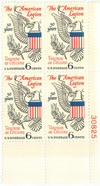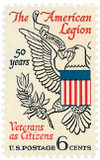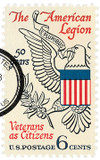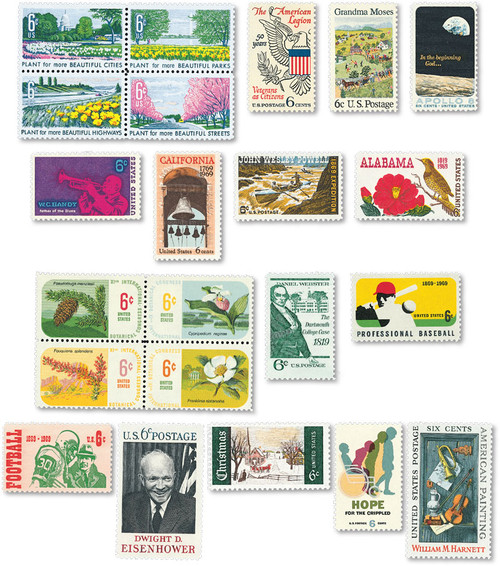
# 1369 - 1969 6c The American Legion
Issue Date: March 15, 1969
Quantity: 148,770,000
Printed By: Bureau of Engraving and Printing
Printing Method: Lithographed, engraved
Perforations: 11
Color: Red, blue and black
First Convention Of The American Legion
On November 10, 1919, the American Legion held its first convention in Minneapolis, Minnesota.
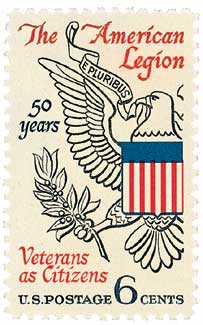
Following the Civil War in the mid-1800s, former soldiers began creating their own organizations. Union soldiers created the Grand Army of the Republic (GAR) while Southern soldiers created the United Confederate Veterans (UCV). After the Spanish-American War, another military-based group was formed, the American Veterans of Foreign Service (which we know today as the Veterans of Foreign Wars or VFW).
By 1915, much of the globe was embroiled in World War I. Adventure magazine staffers Arthur Silluvant Hoffman and Stephen Allan Reynolds decided to form the American Legion strengthen the nation’s military. In a November 1915 article they wrote, “The Legion believes in making instantly available to our country, in case of war, all men who already have military or technical training valuable in modern warfare by land or sea. Members of the Legion enroll themselves in advance for this purpose to be used as the Government (not they themselves) may see fit, according to their qualifications.”
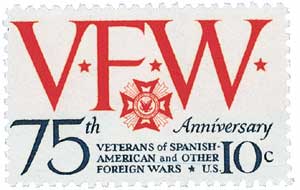
The Legion staged a preparedness parade in New York City and created a film to further their goals. Among their 23,000 members were Theodore Roosevelt and William Howard Taft. The Legion was disbanded in 1917, but the idea lingered.
When World War I ended, many American servicemen waited in France to be transported home. As weeks, then months passed, morale suffered. Then in January 1919, Lieutenant Colonel Theodore Roosevelt, Jr., suggested the immediate creation of a serviceman’s organization for the men in the American Expeditionary Force as well as those still stationed stateside. Roosevelt and National Guard officer George A. White lobbied their commanders relentlessly until they’d gained full support.
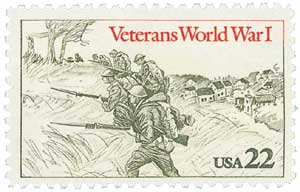
Meanwhile, General John J. Pershing then ordered 20 officers to report to the YMCA headquarters in Paris that February. These officers met for three days to find ways to improve morale. After the first meeting, Roosevelt met with them and told them about his idea for a new veterans society, and they all eagerly supported it. After that meeting they created a provisional executive committee to move the idea forward. Roosevelt returned to America to share the idea with demobilized troops, while White toured AEF camps to garner their support. Other members of the committee returned to America to establish a central office and publicize the organization in the press.
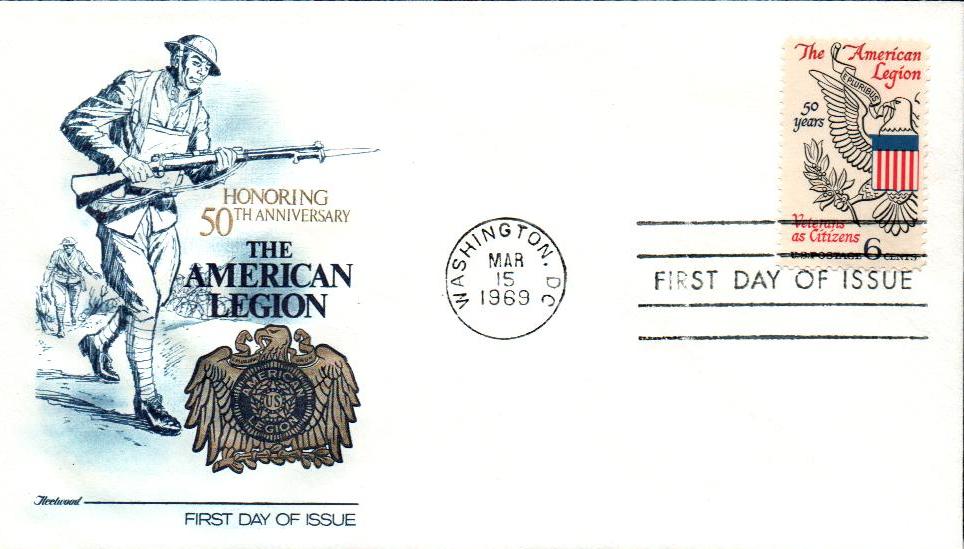
These men put out a call for a convention in Paris to form “one permanent nation-wide organization…composed of all parties, all creeds, and all ranks who wish to perpetuate the relationships formed while in military service.” The Paris caucus began on March 15, 1919. They considered several names, including Veterans of the Great War, Liberty League, American Comrades of the Great War, and Legion of the Great War. But they ultimately selected American Legion. They also drafted a preamble.
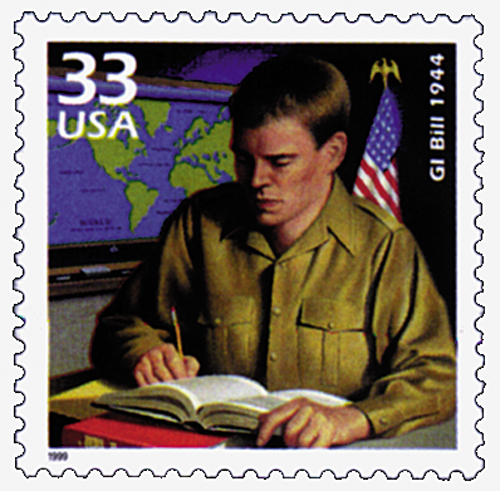
A second caucus was held in St. Louis that May, for soldiers that were already back in America. This caucus wasn’t as productive, though they did select adopt a constitution and select Minneapolis as the site of their formal founding convention that fall.
The official founding convention of the American legion was held from November 10 to 12, 1919, in Minneapolis, Minnesota. Some 684 delegates from around the country attended. They agreed in their constitution not to affiliate with either political party, though this would make politicians from both parties compete for their favor for years. They also established a permanent National Legislative Committee to promote their political objectives. One of the major goals of the new American Legion was to increase the pay received by veterans that were totally disabled by their service. By the end of the year they succeeded in raising this pay from $30 to $80 a month. During this convention, they adopted their constitution and preamble, agreed to station the headquarters in Indianapolis, and passed a resolution supporting the Boy Scouts of America.
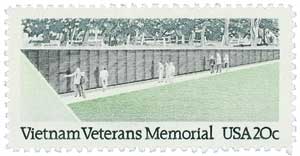
Over the years the American Legion continued to promote the rights of veterans, ultimately leading to the creation of the U.S. Veterans Bureau (later the Veterans Administration) in 1921. Two years later the Legion drafted the first “Flag Code,” which was adopted by Congress in 1942. In the 1940s, the Legion wrote the initial draft of the Veterans Readjustment Act, which ultimately became the GI Bill. Over the years the American Legion has donated millions of dollars to important organizations and projects including the American Heart Association, National Association for Mental Health, the Vietnam Veterans Memorial Fund, and more. Click here for a handy timeline of additional American Legion accomplishments.
Click here to see a photo from the Minneapolis convention.
Issue Date: March 15, 1969
Quantity: 148,770,000
Printed By: Bureau of Engraving and Printing
Printing Method: Lithographed, engraved
Perforations: 11
Color: Red, blue and black
First Convention Of The American Legion
On November 10, 1919, the American Legion held its first convention in Minneapolis, Minnesota.

Following the Civil War in the mid-1800s, former soldiers began creating their own organizations. Union soldiers created the Grand Army of the Republic (GAR) while Southern soldiers created the United Confederate Veterans (UCV). After the Spanish-American War, another military-based group was formed, the American Veterans of Foreign Service (which we know today as the Veterans of Foreign Wars or VFW).
By 1915, much of the globe was embroiled in World War I. Adventure magazine staffers Arthur Silluvant Hoffman and Stephen Allan Reynolds decided to form the American Legion strengthen the nation’s military. In a November 1915 article they wrote, “The Legion believes in making instantly available to our country, in case of war, all men who already have military or technical training valuable in modern warfare by land or sea. Members of the Legion enroll themselves in advance for this purpose to be used as the Government (not they themselves) may see fit, according to their qualifications.”

The Legion staged a preparedness parade in New York City and created a film to further their goals. Among their 23,000 members were Theodore Roosevelt and William Howard Taft. The Legion was disbanded in 1917, but the idea lingered.
When World War I ended, many American servicemen waited in France to be transported home. As weeks, then months passed, morale suffered. Then in January 1919, Lieutenant Colonel Theodore Roosevelt, Jr., suggested the immediate creation of a serviceman’s organization for the men in the American Expeditionary Force as well as those still stationed stateside. Roosevelt and National Guard officer George A. White lobbied their commanders relentlessly until they’d gained full support.

Meanwhile, General John J. Pershing then ordered 20 officers to report to the YMCA headquarters in Paris that February. These officers met for three days to find ways to improve morale. After the first meeting, Roosevelt met with them and told them about his idea for a new veterans society, and they all eagerly supported it. After that meeting they created a provisional executive committee to move the idea forward. Roosevelt returned to America to share the idea with demobilized troops, while White toured AEF camps to garner their support. Other members of the committee returned to America to establish a central office and publicize the organization in the press.

These men put out a call for a convention in Paris to form “one permanent nation-wide organization…composed of all parties, all creeds, and all ranks who wish to perpetuate the relationships formed while in military service.” The Paris caucus began on March 15, 1919. They considered several names, including Veterans of the Great War, Liberty League, American Comrades of the Great War, and Legion of the Great War. But they ultimately selected American Legion. They also drafted a preamble.

A second caucus was held in St. Louis that May, for soldiers that were already back in America. This caucus wasn’t as productive, though they did select adopt a constitution and select Minneapolis as the site of their formal founding convention that fall.
The official founding convention of the American legion was held from November 10 to 12, 1919, in Minneapolis, Minnesota. Some 684 delegates from around the country attended. They agreed in their constitution not to affiliate with either political party, though this would make politicians from both parties compete for their favor for years. They also established a permanent National Legislative Committee to promote their political objectives. One of the major goals of the new American Legion was to increase the pay received by veterans that were totally disabled by their service. By the end of the year they succeeded in raising this pay from $30 to $80 a month. During this convention, they adopted their constitution and preamble, agreed to station the headquarters in Indianapolis, and passed a resolution supporting the Boy Scouts of America.

Over the years the American Legion continued to promote the rights of veterans, ultimately leading to the creation of the U.S. Veterans Bureau (later the Veterans Administration) in 1921. Two years later the Legion drafted the first “Flag Code,” which was adopted by Congress in 1942. In the 1940s, the Legion wrote the initial draft of the Veterans Readjustment Act, which ultimately became the GI Bill. Over the years the American Legion has donated millions of dollars to important organizations and projects including the American Heart Association, National Association for Mental Health, the Vietnam Veterans Memorial Fund, and more. Click here for a handy timeline of additional American Legion accomplishments.
Click here to see a photo from the Minneapolis convention.




